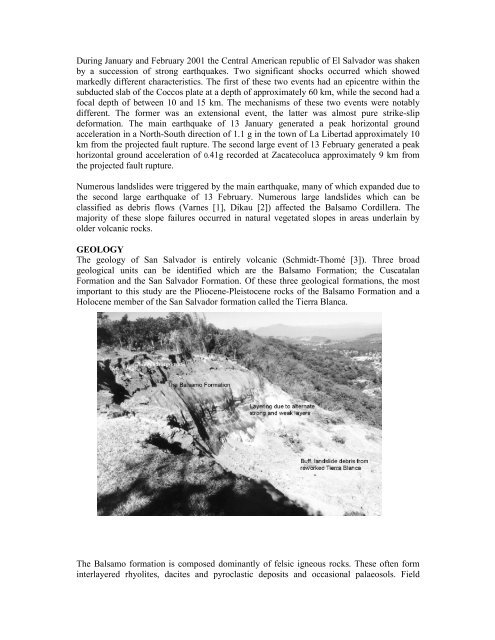mechanisms of slope failure in volcanic soils during earthquakes
mechanisms of slope failure in volcanic soils during earthquakes
mechanisms of slope failure in volcanic soils during earthquakes
Create successful ePaper yourself
Turn your PDF publications into a flip-book with our unique Google optimized e-Paper software.
Dur<strong>in</strong>g January and February 2001 the Central American republic <strong>of</strong> El Salvador was shakenby a succession <strong>of</strong> strong <strong>earthquakes</strong>. Two significant shocks occurred which showedmarkedly different characteristics. The first <strong>of</strong> these two events had an epicentre with<strong>in</strong> thesubducted slab <strong>of</strong> the Coccos plate at a depth <strong>of</strong> approximately 60 km, while the second had afocal depth <strong>of</strong> between 10 and 15 km. The <strong>mechanisms</strong> <strong>of</strong> these two events were notablydifferent. The former was an extensional event, the latter was almost pure strike-slipdeformation. The ma<strong>in</strong> earthquake <strong>of</strong> 13 January generated a peak horizontal groundacceleration <strong>in</strong> a North-South direction <strong>of</strong> 1.1 g <strong>in</strong> the town <strong>of</strong> La Libertad approximately 10km from the projected fault rupture. The second large event <strong>of</strong> 13 February generated a peakhorizontal ground acceleration <strong>of</strong> 0.41g recorded at Zacatecoluca approximately 9 km fromthe projected fault rupture.Numerous landslides were triggered by the ma<strong>in</strong> earthquake, many <strong>of</strong> which expanded due tothe second large earthquake <strong>of</strong> 13 February. Numerous large landslides which can beclassified as debris flows (Varnes [1], Dikau [2]) affected the Balsamo Cordillera. Themajority <strong>of</strong> these <strong>slope</strong> <strong>failure</strong>s occurred <strong>in</strong> natural vegetated <strong>slope</strong>s <strong>in</strong> areas underla<strong>in</strong> byolder <strong>volcanic</strong> rocks.GEOLOGYThe geology <strong>of</strong> San Salvador is entirely <strong>volcanic</strong> (Schmidt-Thomé [3]). Three broadgeological units can be identified which are the Balsamo Formation; the CuscatalanFormation and the San Salvador Formation. Of these three geological formations, the mostimportant to this study are the Pliocene-Pleistocene rocks <strong>of</strong> the Balsamo Formation and aHolocene member <strong>of</strong> the San Salvador formation called the Tierra Blanca.Figure 1. The rocks <strong>of</strong> the Balsamo Formation exposed <strong>in</strong> the head <strong>of</strong> thelandslide at Las Col<strong>in</strong>asThe Balsamo formation is composed dom<strong>in</strong>antly <strong>of</strong> felsic igneous rocks. These <strong>of</strong>ten form<strong>in</strong>terlayered rhyolites, dacites and pyroclastic deposits and occasional palaeosols. Field
















